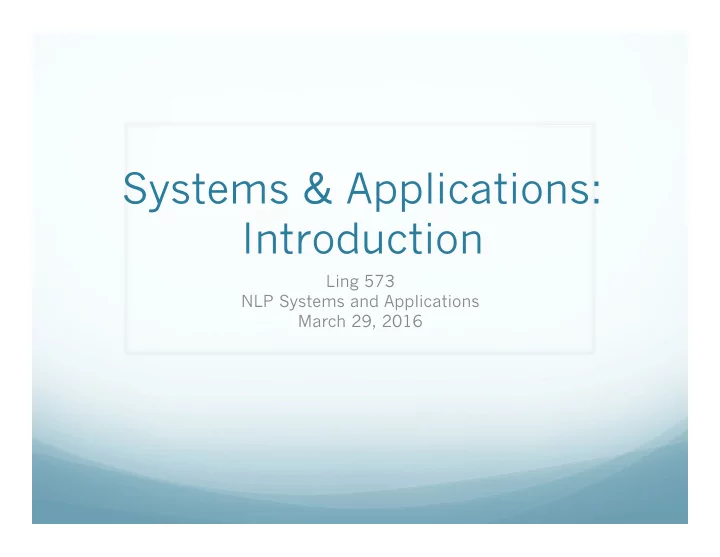

Systems & Applications: Introduction Ling 573 NLP Systems and Applications March 29, 2016
Roadmap Motivation 573 Structure Summarization Shared Tasks
Motivation Information retrieval is very powerful Search engines index and search enormous doc sets Retrieve billions of documents in tenths of seconds But still limited! Technically – keyword search (mostly) Conceptually User seeks information Sometimes a web site or document Sometimes the answer to a question But, often a summary of document or document set
Why Summarization? Even web search relies on simple summarization Snippets! Provide thumbnail summary of ranked document
Why Summarization? Complex questions go beyond factoids, infoboxes Require explanations, analysis E.g. Is acetaminophen or ibuprofen better for reducing fever in kids? Highest search hit is parenting page Provides a multi-document summary
http://www.parents.com/health/hygiene/ childrens-health-myths/#page=1
Why Summarization? Complex questions go beyond factoids, infoboxes Require explanations, analysis E.g. Is acetaminophen or ibuprofen better for reducing fever in kids? Summary: Ibuprofen beats acetaminophen for treating both pain and fever, according to recent research.
Why Summarization? Huge scale, explosive growth in online content 2-4K articles in PubMed daily, 41.7M articles/mo on WordPress alone (2014) How can we manage it? Lots of aggregation sites Effective summarization rarer Recordings of meetings, classes, MOOCs Slow to access linearly, awkward to jump around Structured summary can be useful Outline of: how-tos, to-dos,
Perspectives on Summarization DUC, TAC (2001-…): Single-, multi-document summarization Readable concise summaries Largely news-oriented Later blogs, etc; also query-focused Text simplification: Compress, simplify text for enhanced readability Application to CALL, reading levels (e.g. Simple Wikipedia), assistive technology Also aims to support greater automation
Natural Language Processing and Summarization Rich testbed for NLP techniques: Information retrieval Named Entity Recognition Word, sentence segmentation Information extraction Parsing Semantics, etc.. Discourse relations Co-reference Generation Paraphrasing Deep/shallow techniques; machine learning
573 Structure Implementation: Create a summarization system Extend existing software components Develop, evaluate on standard data set Presentation: Write a technical report Present plan, system, results in class Give/receive feedback
Implementation: Deliverables Complex system: Break into (relatively) manageable components Incremental progress, deadlines Key components: D1: Setup D2: Baseline system, Content selection D3: Content selection, Information ordering D4: : Content selection, Information ordering, Surface realization, final results Deadlines: Little slack in schedule; please keep to time Timing: ~12 hours week; sometimes higher
Presentation Technical report: Follow organization for scientific paper Formatting and Content Presentations: 10-15 minute oral presentation for deliverables Explain goals, methodology, success, issues Critique each others’ work Attend ALL presentations
Working in Teams Why teams? Too much work for a single person Representative of professional environment Team organization: Form groups of 3 (possibly 2) people Arrange coordination Distribute work equitably All team members receive the same base grade End-of-course team evaluation Self- and teammate evaluation Grades may be adjusted in case of severe imbalance
First Task Form teams: Email Glenn gslayden@uw.edu with the team list
Resources Readings: Current research papers in summarization Jurafsky & Martin/Manning & Schutze text Background, reference, refresher Software: Build on existing system components, toolkits NLP , machine learning, etc Corpora, etc
Resources: Patas System should run on patas Existing infrastructure Software systems Corpora Repositories
Shared Task Evaluations Goals: Lofty: Focus research community on key challenges ‘Grand challenges’ Support the creation of large-scale community resources Corpora: News, Recordings, Video Annotation: Expert questions, labeled answers,.. Develop methodologies to evaluate state-of-the-art Retrieval, Machine Translation, etc Facilitate technology/knowledge transfer b/t industry/acad.
Shared Task Evaluation Goals: Pragmatic: Head-to-head comparison of systems/techniques Same data, same task, same conditions, same timing Centralizes funding, effort Requires disclosure of techniques in exchange for data Base: Bragging rights Government research funding decisions
Shared Tasks: Perspective Late ‘80s-90s: ATIS: spoken dialog systems MUC: Message Understanding: information extraction TREC (Text Retrieval Conference) Arguably largest ( often >100 participating teams) Longest running (1992-current) Information retrieval (and related technologies) Actually hasn’t had ‘ad-hoc’ since ~2000, though Organized by NIST
TREC Tracks Track: Basic task organization Previous tracks: Ad-hoc – Basic retrieval from fixed document set Cross-language – Query in one language, docs in other English, French, Spanish, Italian, German, Chinese, Arabic Genomics Spoken Document Retrieval Video search Question Answering
Other Shared Tasks International: CLEF (Europe); FIRE (India) Other NIST: Machine Translation Topic Detection & Tracking Various: CoNLL (NE, parsing,..); SENSEVAL: WSD; PASCAL (morphology); BioNLP (biological entities, relations) Mediaeval (multi-media information access)
Summarization History “The Automatic Creation of Literature Abstracts” Luhn, 1956 Early IBM system based on word, sentence statistics 1993 Dagstuhl seminar: Meeting launched renewed interest in summarization 1997 ACL summarization workshop
Summarization Campaigns SUMMAC: (1998) Initial cross-system evaluation campaign DUC (Document Understanding Conference) 2001-2007 Increasing complexity, including multi-document, topic- oriented, multi-lingual Developed systems and evaluation in tandem NTCIR (3 years) Single, multi-document; Japanese
Most Recent Summarization Campaigns TAC (Text Analytics Conference): 2008---current Variety of tasks Summarization systems: Opinion Update Guided Multi-lingual Automatic evaluation methodology CL-SCISUMM: 2 nd version happening now Scientific document summarization Facets and citations
Summarization Tasks Provide: Lists of topics (e.g.”guided” summarization) Document collections (licensed via LDC, NIST) Lists of relevant documents Validation tools Evaluation tools: Model summaries, systems Derived resources: Baseline systems, pre-processing tools, components Reams of related publications
Topics <topic id = "D0906B" category = "1"> <title> Rains and mudslides in Southern California </title> <docsetA id = "D0906B-A"> <doc id = "AFP_ENG_20050110.0079" /> <doc id = "LTW_ENG_20050110.0006" /> <doc id = "LTW_ENG_20050112.0156" /> <doc id = "NYT_ENG_20050110.0340" /> <doc id = "NYT_ENG_20050111.0349" /> <doc id = "LTW_ENG_20050109.0001" /> <doc id = "LTW_ENG_20050110.0118" /> <doc id = "NYT_ENG_20050110.0009" /> <doc id = "NYT_ENG_20050111.0015" /> <doc id = "NYT_ENG_20050112.0012" /> </docset> <docsetB id = "D0906B-B"> <doc id = "AFP_ENG_20050221.0700" /> ……
Documents <DOC><DOCNO> APW20000817.0002 </DOCNO> <DOCTYPE> NEWS STORY </DOCTYPE><DATE_TIME> 2000-08-17 00:05 </ DATE_TIME> <BODY> <HEADLINE> 19 charged with drug trafficking </HEADLINE> <TEXT><P> UTICA, N.Y . (AP) - Nineteen people involved in a drug trafficking ring in the Utica area were arrested early Wednesday, police said. </P><P> Those arrested are linked to 22 others picked up in May and comprise ''a major cocaine, crack cocaine and marijuana distribution organization,'' according to the U.S. Department of Justice. </P>
Recommend
More recommend